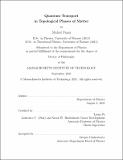Quantum Transport in Topological Phases of Matter
Author(s)
Papaj, Michal
DownloadThesis PDF (8.514Mb)
Advisor
Fu, Liang
Terms of use
Metadata
Show full item recordAbstract
Topological phases of matter attract constant attention in the condensed matter physics community, both due to the fundamental yet simple principles that govern them, and a multitude of experimental observations with the potential for technological applications. Among the ways of studying such materials, quantum transport methods prove to be of particular importance. In this thesis, I touch upon many aspects of quantum transport in topological materials. First, I introduce a novel type of Hall effect, called Magnus Hall effect, that allows one to probe Berry curvature in ballistic, time-reversal invariant systems that break inversion symmetry. Next, I present a detailed characterization of extrinsic Nernst effect in Dirac and Weyl semimetals, providing interpretation of existing experimental results and predictions for new enhanced responses in materials such as Fe3Sn2. In the following section, I demonstrate that a strong disorder can lead to a novel behavior of Dirac fermions in surface states of topological crystalline insulators, resulting in appearance of nodal arcs in place of Dirac points and in tilting of the Dirac cone. In the second part of the thesis, I focus on topological superconductors, starting by presenting a new method for creating Majorana zero modes using segmented Fermi surface. This approach, based on the Fermi surface of Bogoliubov quasiparticles allows for the reduction of the magnetic field required to induce a topological phase transition and reduces the number of spurious, low energy modes that hamper observation and utilization of Majorana zero modes. Finally, I show that the presence of multiple Majorana modes in a strongly correlated superconducting island leads to Kondo-like behavior with a topological twist.
Date issued
2021-09Department
Massachusetts Institute of Technology. Department of PhysicsPublisher
Massachusetts Institute of Technology